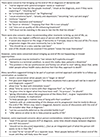Optimizing Advance Care Planning in Dementia: Recommendations From a 33-Country Delphi Study
- PMID: 40032035
- PMCID: PMC12551429
- DOI: 10.1016/j.jpainsymman.2025.02.471
Optimizing Advance Care Planning in Dementia: Recommendations From a 33-Country Delphi Study
Abstract
Context: Advance care planning (ACP) is relevant yet challenging with cognitive decline.
Objective: To provide evidence and consensus-based clinical recommendations for how to conduct ACP in dementia.
Methods: International Delphi study conducted by the European Association for Palliative Care 'ACP in dementia' taskforce with four online surveys (September 2021-June 2022). A panel of 107 experts from 33 countries and seven individuals with dementia contributed. The recommendations specific for dementia were initially based on two earlier Delphi studies and literature searches addressing guidance including the right timing and how to personalize ACP. We used conservative preregistered criteria for consensus.
Results: Thirty constitutive elements of ACP were identified (e.g., 'assess understanding of ACP'). Only five were deemed 'optional.' The panel estimated a median of four conversations could address elements to be addressed at least once. Recommendations included to assume capacity as a principle, conscious of the need to explore its fluctuation, to encourage engaging and playing active roles, and to establish connection and inform and prepare family. There was a consensus to offer ACP around dementia diagnosis, to raise end-of-life issues later, and to personalize ACP with flexibility, providing of information and exploring understanding. The advice of the persons with dementia pointed to a wish for a well-coordinated holistic approach.
Conclusion: Consensus was reached, including in areas of ambiguity, to guide ACP in dementia. ACP should be embedded in a nonprescriptive, individualized approach that involves both the person with dementia and their families. Future studies may evaluate trade-offs between optimal ACP and feasible implementation.
Keywords: Advance care planning; decision making; dementia; end of life; guidelines; palliative care.
Copyright © 2025 The Authors. Published by Elsevier Inc. All rights reserved.
Conflict of interest statement
Disclosures
The authors declare no conflict of interest.
Figures





References
-
- Bosisio F, Jox RJ, Jones L, Rubli Truchard E. Planning ahead with dementia: what role can advance care planning play? A review on opportunities and challenges. Swiss Med Wkly 2018;148:w14706. - PubMed
MeSH terms
Grants and funding
LinkOut - more resources
Full Text Sources
Medical

